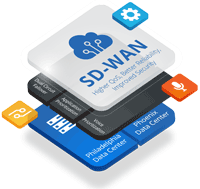WAN Optimization vs SD WAN Networks. Today’s Challenges & Difficulties for WAN Optimization
 Enterprises have been successfully running WAN optimization appliances at their many distributed sites for years. The devices have done a good job of helping businesses squeeze as much capacity as possible out of their WAN links and to improve performance across low-bandwidth, long-distance network circuits.
Enterprises have been successfully running WAN optimization appliances at their many distributed sites for years. The devices have done a good job of helping businesses squeeze as much capacity as possible out of their WAN links and to improve performance across low-bandwidth, long-distance network circuits.
WAN optimizers were a boon to telecom budgets when network bandwidth was particularly pricey. Businesses also have used the devices to prioritize applications that are sensitive to delay and packet loss--particularly when traffic is shuttled among corporate-controlled sites.
However, changes in network traffic patterns and application protocols, the tendency to encrypt data in transit, the emergence of software-defined WAN (SD-WAN) and other factors are all challenging the need for WAN optimization in the edge appliance form factor that IT shops have traditionally deployed.
Shifting Network Landscape
 While historically most application requests were directed inward, toward corporate data centers, most are now outbound, toward cloud and Internet locations. As the software as a service (SaaS) computing model continues to gain steam, these trends will only get stronger.
While historically most application requests were directed inward, toward corporate data centers, most are now outbound, toward cloud and Internet locations. As the software as a service (SaaS) computing model continues to gain steam, these trends will only get stronger.
With much of corporate traffic headed toward the cloud, enterprises have little or no control over the far-end site. As a result, it becomes difficult to support a network topology requiring optimization appliances at both ends of the WAN link. Ever try asking Salesforce.com if you could install your own, specially configured WAN optimization appliance in their network? Good luck.
In addition, today’s security schemes can throw a wrench into traditional WAN optimization setups. Nearly all cloud-bound traffic is SSL/TLS-encrypted from the workstation to the cloud using keys that aren’t readily accessible. WAN optimizers can’t see that traffic to shape or treat it, unless the device is brought into the certification path for decryption and re-encryption before delivery. Adding that step introduces a processing burden to the optimization appliance that can impede scalability.
Another change factor is that Internet bandwidth is more plentiful than it was when WAN optimizers came to market, and it’s far more affordable than MPLS capacity. So the requirement to compress data and deduplicate packets to conserve expensive bandwidth, which traditional WAN optimizers are good at, has become less stringent.
Duplication Of Effort
There are also other ways to get some of the traditional WAN optimizer’s benefits baked right into services. Some cloud service providers, such as Amazon with its AWS Global Accelerator service, for example, help improve connections to their services, encroaching a bit on the traditional WAN optimization appliance’s turf.
Today, those WAN links are carrying predominantly HTTP and TCP traffic. That means that the need to accelerate various other application-specific protocols is disappearing. The acceleration capabilities for IP-based traffic offered by cloud providers such as Amazon are now more in demand than the multiprotocol acceleration function of traditional WAN optimizers.
The deduplication and compression capabilities of WAN optimization appliances remain beneficial. However, there is less of a need for them because of greater availability of network capacity. And cloud computing is bringing data closer to users to decrease distance-based latency.
Emergence Of SD-WANs
Amid all these WAN changes, SD-WANs have taken the industry by storm, affording the opportunity to offload traffic from pricey MPLS circuits onto lower-cost links. By incorporating dynamic path selection--the ability to route traffic across the best-performing WAN link available at the moment of transmission--the SD-WAN is subsuming a portion of the WAN optimization role. SD-WANs are still in hockey-stick growth mode, with IDC predicting a 40% compound annual growth rate through 2022.

The SD-WAN cloud is clearly the future of WAN Networking
SD-WANs, depending on the vendor, incorporate other optimization capabilities, too, such as packet-loss correction technology, TCP proxies to compensate for network latency, traffic shaping, and quality of service (QoS) priority marking.
Managed SD-WAN services, or cloud-based SD-WAN, are particularly appealing for the performance improvements they yield. In this setup, your SD-WAN service provider generally runs a private IP network, which it controls end to end. That puts the provider back in the seat of controlling both ends of your connection by linking your sites to its own backbone points of presence all over the world. That means your traffic is no longer subjected to the “best effort” nature of the public Internet, where it traverses circuits managed by multiple providers.
Different Approaches
Enterprises will always want their WAN traffic treated as efficiently as possible with the best possible application performance and response times. But where WAN optimization appliances (or WAN optimization built into edge routers) were once the sole source of application acceleration, the changing WAN landscape means that optimization is being handled in different ways. These include acceleration techniques offered by cloud vendors and, most notably, by popular SD-WAN offerings.
Where WAN optimization takes place will depend on whether you deploy SD-WAN and, if you do, which SD-WAN deployment model you choose: on-premises or as a managed, cloud-based service. One way or another, enterprises should address WAN performance so that their long-haul, particularly global, transmissions don’t sputter and choke response times of their critical applications.
Your IP address:
3.145.216.39
Wi-Fi Key Generator
Follow Firewall.cx
Cisco Password Crack
Decrypt Cisco Type-7 Passwords on the fly!













